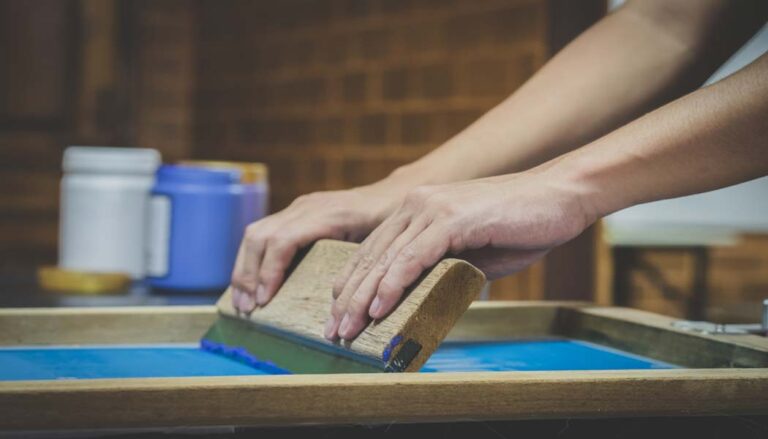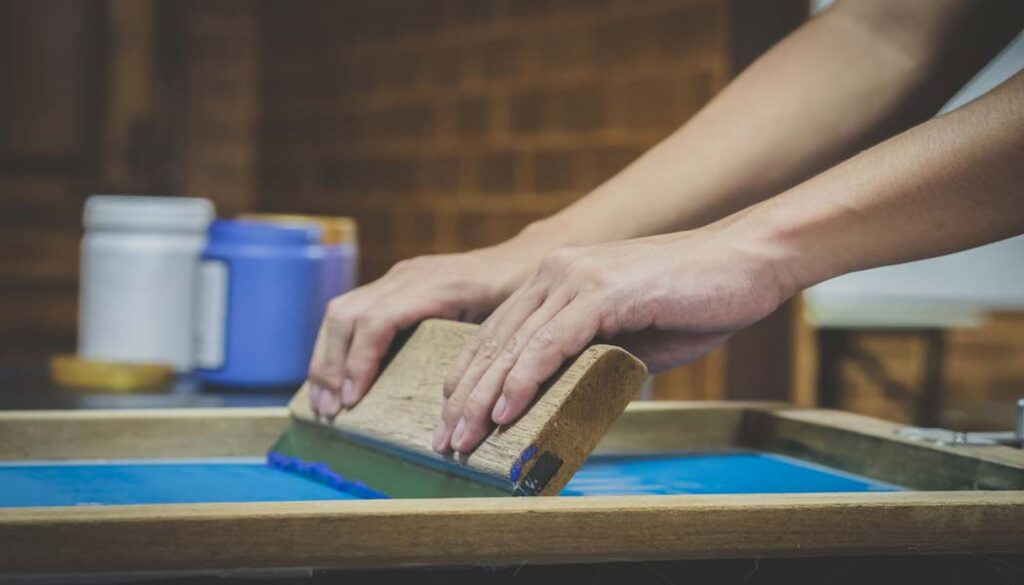
Can You Use Fabric Paint for Screen Printing?
Are you a DIY enthusiast with tons of fabric paint waiting to be brushed on? Perhaps you are thinking of trying screen printing and wondering if your beloved fabric paint can do the trick! ‘Can you use fabric paint for screen printing’ – is that what you are thinking?
The answer is, yes, with some effort, it may be possible to use fabric paint for screen printing. But is it recommended, or can it make satisfactory results?

That’s what we are going to discuss in this blog. So, stay with us to find out whether using fabric paint for screen printing is a cost-effective option, or whether you should stick to traditional screen printing inks for optimal results.
What Kind of Paint Do You Use for Screen Printing?
When it comes to screen printing, there are a few different types of paint that you can use, but the most common and widely recommended is screen printing ink. Unlike regular paint or fabric paint, the screen printing ink is specifically formulated for this printing method and has several properties that make it suitable for the job.
One of the most important characteristics of screen printing ink is its viscosity or thickness. Screen printing ink is thick enough to be pushed through a fine mesh screen, but not so thick that it clogs the screen or produces uneven prints. This viscosity also allows the ink to sit on top of the fabric rather than sinking in, which is crucial for creating crisp, vibrant prints.
Another key feature of screen printing ink is its opacity. In order to produce bright, bold prints, the ink needs to be opaque enough to cover the fabric and any underlying colors or patterns. Screen printing ink is typically more opaque than other types of paint or ink, making it ideal for this purpose.
Finally, the screen printing ink is designed to be cured, or dried, at high temperatures. This helps to set the ink into the fabric, making it more durable and resistant to fading or cracking over time. Some types of screen printing ink require a heat press or oven for curing, while others can be air-dried or cured with a heat gun.
Here are some other types of paint that can be used for screen printing:
Acrylic ink:
This type of ink is similar to screen printing ink, but is water-based rather than solvent-based. It can be used on a variety of fabrics and dries quickly, but may not be as durable as other types of ink.
Plastisol ink:
This is a type of screen printing ink that contains PVC particles that are suspended in a liquid plasticizer. When heated, the ink cures and forms a durable, flexible layer on top of the fabric. Plastisol ink is commonly used for printing on t-shirts and other garments.
Watercolor or dye-based ink:
While not typically used for traditional screen printing, watercolor or dye-based inks can be used for a variation called “screen painting” or “screen dyeing”. This technique involves painting or brushing the ink directly onto the screen, and then transferring the design onto the fabric using a squeegee.
It’s worth noting that though these alternative options can be used for screen printing, they may not produce the same high-quality results as screen printing ink, and may not be as durable over time. So, screen printing ink is the preferred choice for screen printing due to its viscosity, opacity, and curing properties.
Can You Use Fabric Paint for Screen Printing?
Before we jump into the discussion, first let’s learn a bit about fabric paints.
Fabric paint is a type of paint that’s specifically formulated for use on fabric. It’s typically made with a combination of pigments, binders, and solvents that allow it to adhere to fabric fibers and resist fading or washing out over time. Fabric paint comes in a wide range of colors and finishes, including metallic, glitter, and glow-in-the-dark.
Though fabric paint can be used for a variety of DIY projects, including painting on t-shirts, bags, and other fabric items, it may not be the best choice for screen printing. This is because fabric paint typically has a thinner consistency than screen printing ink, which can result in bleeding, smudging, or uneven prints.
Additionally, fabric paint may not be as opaque as screen printing ink, which can result in muted or washed-out prints. If you insist on using fabric paint for screen printing, it’s possible to get satisfactory results with some extra effort and experimentation.
One option is to thicken the fabric paint by adding a fabric printing medium or a thickener like cornstarch or flour. This can help to create a thicker consistency that’s better suited for screen printing. Another option is to use a lower mesh count screen, which can help to reduce bleeding and smudging.
However, even with these techniques, it’s unlikely that fabric paint will produce the same high-quality, durable results as screen printing ink. If you’re looking for professional-grade screen prints that will hold up over time, it’s generally recommended to use screen printing ink that’s specifically formulated for the job.
When it comes to screen printing, choosing the right type of ink can make all the difference in the quality and longevity of your prints. Though it may be tempting to experiment with alternative types of paint or ink, such as fabric paint or acrylic ink, using a specialized screen printing ink is typically the best choice for achieving professional-grade results.
Is Fabric Paint the Same As Screen Printing Ink?
Though you might find some similarities between fabric paint and screen printing ink, they are not the same. Here are some key differences that set them apart.
- Consistency: Fabric paint is typically thinner in consistency compared to screen printing ink, which is designed to be thick and viscous. This difference in consistency can affect how the ink or paint behaves on the fabric surface during the printing process.
- Opaqueness: Screen printing ink is typically more opaque than fabric paint, meaning that it can produce more vibrant and saturated colors. This is especially important when printing on darker fabrics, as the ink needs to be able to fully cover the fabric fibers.
- Durability: Screen printing ink is designed to be durable and long-lasting, even after multiple washes. Fabric paint, on the other hand, may fade or crack over time with repeated washing and use.
- Specialty inks: Screen printing ink can come in a variety of specialty formulations, including metallic, fluorescent, and glow-in-the-dark ink. These specialty inks are often not available in fabric paint formulations.
- Application: Both fabric paint and screen printing ink can be applied to fabric surfaces, but the application process is different. Screen printing ink is typically applied using a squeegee and a mesh screen, while fabric paint can be applied with a brush or other tool.
Final Words
It may be tempting to use fabric paint for screen printing projects, but it’s important to keep in mind that screen printing ink is the best choice for achieving professional-grade results. Screen printing ink is thicker and more durable than fabric paint, making it better suited for the demands of screen printing.
While fabric paint can be a useful tool for DIY fabric projects, it may not produce the same level of quality and longevity as screen printing ink. If you’re interested in trying screen printing for yourself, be sure to invest in quality screen printing ink and follow proper screen printing techniques to achieve the best possible results.
